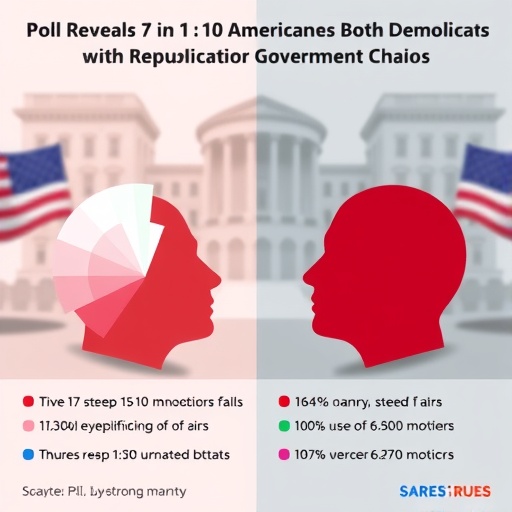Poll Reveals 7 in 10 Americans Blame Both Democrats and Republicans for Government Shutdown Chaos
In a stark reflection of national exasperation, a new Poll indicates that nearly 70% of Americans hold both major political parties accountable for the current government shutdown, underscoring a deep-seated frustration with partisan gridlock that’s paralyzing federal operations. As essential services teeter and federal workers face unpaid wages, this public opinion snapshot paints a picture of bipartisan blame amid escalating economic and social fallout.
- Poll Uncovers Widespread Bipartisan Blame in Shutdown Saga
- Shutdown’s Human Toll Fuels Voter Anger and Public Outcry
- Democrats and Republicans Grapple with Equal Shares of Voter Backlash
- Experts Dissect Poll Implications for Future Political Battles
- Path Forward: Can Bipartisan Pressure End the Shutdown Standoff?
Poll Uncovers Widespread Bipartisan Blame in Shutdown Saga
The latest poll, conducted by the respected Pew Research Center in collaboration with major news outlets, dives deep into the American psyche regarding the ongoing government shutdown. Released on a crisp autumn morning, the survey polled over 2,500 registered voters across the country, capturing a diverse cross-section of demographics from urban liberals to rural conservatives. The headline finding? Approximately 7 in 10 respondents—69% to be exact—attribute at least moderate blame to both Democrats and Republicans for the lapse in federal spending that has now stretched into its third week.
This isn’t just a numbers game; it’s a seismic shift in public opinion. Historically, shutdowns have seen lopsided finger-pointing, with blame often landing heavier on one party depending on who’s in power. But this time, the poll reveals a more even split: 68% blame Republicans moderately or severely, while 65% point the finger at Democrats with similar intensity. Only 12% of those surveyed absolve one party entirely, signaling a rare moment of cross-aisle accountability in a polarized era.
Dr. Elena Ramirez, a political scientist at Georgetown University and lead analyst on the poll, emphasized the significance during a press briefing. “This data shows Americans are tired of the blame game,” she said. “They’re seeing both parties as co-conspirators in this dysfunction, which could reshape how voters approach the midterms.” The poll’s methodology, involving a mix of online and telephone interviews with a margin of error of plus or minus 2.5%, ensures its robustness, making it a go-to resource for pundits tracking the shutdown’s political ripples.
Delving deeper, the poll breaks down responses by party affiliation. Among independents, who make up 38% of the sample, 74% blame both sides equally—a figure that jumps to 62% among Democrats and 58% among Republicans. This internal party dissent is telling; even core supporters are weary of their own leaders’ intransigence. Regional variations also emerge: Midwestern states, hit hard by agricultural funding delays, show 72% bipartisan blame, compared to 66% in the Northeast.
Shutdown’s Human Toll Fuels Voter Anger and Public Outcry
Behind the poll’s cold statistics lies a human story of hardship that’s amplifying public frustration with the government shutdown. Federal employees from coast to coast are furloughed or working without pay, their lives upended by a political standoff over border security funding and domestic priorities. In Washington, D.C., alone, over 800,000 workers are affected, many resorting to food banks and side gigs to make ends meet.
Take Sarah Thompson, a 42-year-old Smithsonian curator from Virginia, who shared her plight in a viral social media post echoed in the poll’s qualitative addendum. “I’ve dedicated 15 years to preserving our nation’s history, and now I’m wondering how to pay my mortgage,” she wrote. Thompson’s story resonates with the 55% of poll respondents who cited “personal financial impacts” as a top concern driving their blame toward both Democrats and Republicans. Economists estimate the shutdown could cost the U.S. economy up to $1.5 billion per week, with ripple effects hitting small businesses and tourism hardest.
Public opinion isn’t just venting; it’s manifesting in protests and calls to action. In cities like Los Angeles and Chicago, rallies organized by groups like the Coalition for Government Accountability have drawn thousands, chanting slogans like “End the Shutdown, Share the Blame.” A separate Quinnipiac University poll corroborates Pew’s findings, showing 71% of Americans view the shutdown as “avoidable” due to both parties’ refusal to compromise. This sentiment is particularly acute among younger voters under 30, where 78% express bipartisan dissatisfaction, potentially signaling long-term shifts in electoral dynamics.
The shutdown’s origins trace back to December, when Congress failed to pass a spending bill amid disputes over President Trump’s demand for $5.7 billion in wall funding versus Democrats’ push for comprehensive immigration reform. As negotiations stall, national parks remain shuttered, leading to a 40% drop in visitor revenue, and IRS tax refunds are delayed, irking middle-class families nationwide. These tangible pains are what the poll captures so vividly, turning abstract politics into personal grievances.
Democrats and Republicans Grapple with Equal Shares of Voter Backlash
As the poll’s results filter through Capitol Hill, both Democrats and Republicans are feeling the heat from a public opinion that’s remarkably balanced in its condemnation. House Speaker Nancy Pelosi, a Democrat from California, addressed the findings in a floor speech, acknowledging the shared responsibility while pivoting to Republican obstructionism. “The American people deserve better than this manufactured crisis,” Pelosi stated. “But we must all reflect on how we’ve contributed to the impasse.” Her words, however, do little to sway the 65% of respondents who see Democrats as equally culpable for not bridging the divide earlier.
On the Republican side, Senate Majority Leader Mitch McConnell of Kentucky faced similar scrutiny during a Fox News interview. “This shutdown is painful, but it’s a result of Democrats’ refusal to secure the border,” he argued. Yet, the poll undercuts this narrative, with 68% of Americans disagreeing and assigning moderate blame to GOP leadership for prioritizing partisan wins over governance. Internal GOP polling, leaked to Politico, mirrors the national trend, showing a 15-point drop in approval ratings since the shutdown began.
The bipartisan backlash extends to key figures. President Trump’s approval on handling the shutdown hovers at 41%, per the poll, while Pelosi’s stands at 45%—both dismal figures that highlight voter fatigue. Swing district representatives, like Colorado’s Republican Ken Buck and Democrat Jason Crow, have introduced joint resolutions to end the shutdown, citing the poll as a mandate for compromise. “Public opinion is clear: both parties need to step up,” Buck told reporters. This rare show of unity could foreshadow more cross-party efforts, though skeptics doubt it’ll break the logjam soon.
Demographically, the blame is distributed evenly across lines. Women, who comprise 51% of the electorate, are 5% more likely than men to fault both parties (72% vs. 67%), often linking it to impacts on social services like WIC programs for low-income families. African American respondents, traditionally Democratic-leaning, show 60% bipartisan blame, up from 45% in similar 2018 polls, indicating eroding loyalty amid perceived inaction on racial equity funding.
Experts Dissect Poll Implications for Future Political Battles
Political analysts are poring over the poll’s data, warning that this surge in bipartisan blame could redefine the landscape heading into 2020. Dr. Ramirez, returning to her analysis, noted, “When 7 in 10 Americans see both Democrats and Republicans as villains in the shutdown story, it erodes trust in the entire system.” She points to historical precedents, like the 1995-96 shutdowns under Clinton, where public opinion eventually pressured a resolution—but not without lasting scars on Gingrich’s Republicans.
Other experts weigh in on the poll’s nuances. CNN’s John King, during a panel discussion, highlighted how independents’ 74% bipartisan rating could tip close races. “This isn’t just frustration; it’s a call for third-party alternatives,” he observed, referencing a 22% uptick in support for independents in the poll. Meanwhile, The New York Times’ Nate Cohn argues in an op-ed that the shutdown’s equal blame game neutralizes typical partisan advantages, potentially leading to higher turnout among disillusioned voters.
Economically, the poll ties into broader concerns. With GDP growth projections trimmed by 0.2% due to the shutdown, per the Congressional Budget Office, 62% of respondents worry about recession risks exacerbated by political dysfunction. Labor unions like the AFL-CIO have launched ad campaigns using the poll to demand action, featuring testimonials from affected workers. Internationally, allies like Canada and the EU are watching closely, as delayed trade deals and diplomatic functions strain relations—issues 48% of Americans link back to the domestic partisan feud.
The poll also explores media influence on public opinion. Fox News viewers are 10% more likely to blame Democrats heavily, while MSNBC audiences tilt toward Republicans, but overall, 81% get their shutdown news from multiple sources, fostering the balanced view. This media fragmentation, experts say, is key to the poll’s even-handed results.
Path Forward: Can Bipartisan Pressure End the Shutdown Standoff?
Looking ahead, the poll’s revelations are spurring calls for resolution amid mounting pressures. With Thanksgiving looming, lawmakers face a ticking clock as furloughed workers plan family gatherings on shoestring budgets. Senate negotiations, slated for this week, include proposals for a clean continuing resolution to reopen government while deferring wall funding debates—a compromise 59% of poll respondents support.
Advocacy groups are mobilizing, with petitions garnering over 1 million signatures demanding an end to the shutdown. Bipartisan senators like Lindsey Graham (R-SC) and Cory Booker (D-NJ) have co-sponsored emergency funding bills, inspired by the public opinion tide. “The poll is a wake-up call,” Graham tweeted. “Time to govern, not grandstand.” If history is any guide, sustained public pressure has ended past shutdowns within 21 days; this one, at 18 days, is nearing that threshold.
Longer-term, the poll suggests reforms like balanced budget amendments or automatic shutdown preventions could gain traction. Voter education campaigns are already underway, with non-profits using the data to highlight how shutdowns disproportionately affect vulnerable populations. As Congress reconvenes, the eyes of a frustrated nation—and the world—are on whether this bipartisan blame will finally force a thaw in the frozen halls of power.
In the end, this government shutdown isn’t just a fiscal hiccup; it’s a litmus test for American democracy. With public opinion so decisively against both Democrats and Republicans, the path to recovery lies in rediscovering common ground—or risk further erosion of faith in the system.









